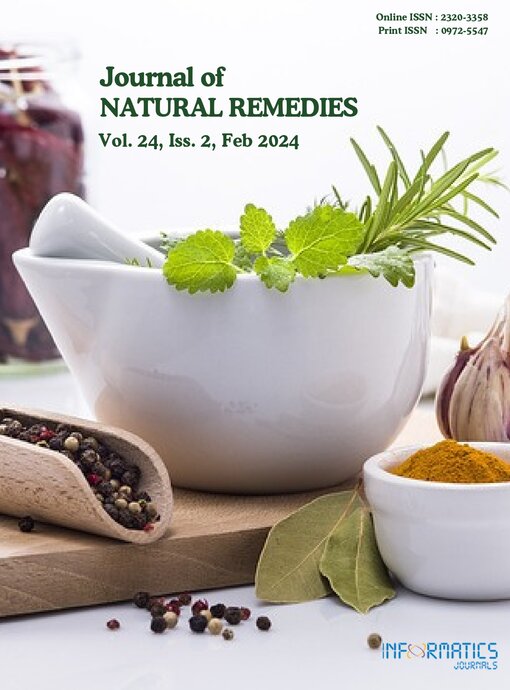Phytochemical Analysis and Elemental Contents of Varieties of Polyalthia longifolia (Sonn.) Thwaites
DOI:
https://doi.org/10.18311/jnr/2024/32921Keywords:
Elemental Content, Fingerprint, Phytochemical Analysis, Polyalthia longifoliaAbstract
Polyalthia longifolia (Sonn.) is a medicinal plant that belongs to the family Annonaceae, and it is distributed in the tropics. This plant is widely grown in West Africa for its ornamental and medicinal purposes. There are two varieties of P. longifolia which are commonly distinguishable by the direction of their branches. One has spreading perpendicular branches, and the other has drooping pendulous branches. Traditional herbal practitioners believe that one variety (P. longifolia cv. pendula) is more medicinal than the other. This study, therefore, sought to investigate the phytochemical components of the two varieties of P. longifolia by HPTLC, UPLC, and elemental analysis by ICP-EOS. No observable differences were found in the phytochemical and elemental profiles of these varieties that could help distinguish one from the other or could account for its supposed differences in medicinal properties. A total of 22 elements were detected in the samples of the two varieties of the plant. Qualitatively, the elemental content of both varieties was similar. Only Iridium was not detected in all samples. Heavy metals including As, Pb, Cd, and Hg had their levels above the recommended limits.
Downloads
Metrics
Downloads
Published
How to Cite
Issue
Section
License
Copyright (c) 2024 Emelia Oppong Bekoe, Emmanuel Orman, Michael Lartey, Andrew Gordon, Tonny Asafo-Agyei (Author)

This work is licensed under a Creative Commons Attribution 4.0 International License.
Accepted 2023-10-12
Published 2024-02-01
References
Chase MW, Christenhusz MJ, Fay MF, Byng JW, Judd WS, et al. Angiosperm Phylogeny Group. An update of the angiosperm phylogeny group classification for the orders and families of flowering plants: APG IV. Bot J Linn. 2016; 181(1):1-20. https://doi.org/10.1111/boj.12385 DOI: https://doi.org/10.1111/boj.12385
Sivashanmugam AT, Chatterjee TK. Anticataractogenesis activity of Polyalthia longifolia leaves extracts against glucose-induced cataractogenesis using goat lenses in vitro. Euro J Exp Biol. 2012; 2(1):105-13.
Lestari DA, Azrianingsih R, Hendrian H. Taxonomical position of Annonaceae species from East Java, Indonesia: Collections of Purwodadi Botanic Garden based on morphological character. Biodiversitas. 2017; 18(3):1067- 76. https://doi.org/10.13057/biodiv/d180326 DOI: https://doi.org/10.13057/biodiv/d180326
Bankole AE, Adekunle AA, Sowemimo AA, Umebese CE, Abiodun O, Gbotosho GO. Phytochemical screening and in vivo antimalarial activity of extracts from three medicinal plants used in malaria treatment in Nigeria. Parasitol Res. 2016; 115(0):299–305. https://doi.org/10.1007/s00436-015- 4747-x DOI: https://doi.org/10.1007/s00436-015-4747-x
Obaid AK, Abdul Azziz SSS, Bakri YM, Nafiah MA, Awang K, Aowda SA, et al. Antioxidative and cytotoxic activities of crude and isolated compounds of P. lateriflora (Bl.) King. J Pharm Sci Res. 2018; 10(11):2718-21.
Katkar KV, Suthar AC, Chauhan VS. The chemistry, pharmacologic, and therapeutic applications of Polyalthia longifolia. Pharmacogn Rev. 2010; 4 (7):62-8. https://doi. org/10.4103/0973-7847.65329 DOI: https://doi.org/10.4103/0973-7847.65329
Kwansa-Bentum B, Agyeman K, J. L-A, Anyigba C, Appiah-Opong R. In vitro assessment of antiplasmodial activity and cytotoxicity of Polyalthia longifolia leaf extracts on Plasmodium falciparum strain NF54. Malar Res Treat. 2019; 2019:1-9. https://www.ncbi.nlm.nih.gov/ pubmed/30805129. https://doi.org/10.1155/2019/6976298 DOI: https://doi.org/10.1155/2019/6976298
Cudjoe E, Donu D, Okonu R, Amponsah JA, Amoah LE. The in vitro antiplasmodial activities of aqueous extracts of selected ghanaian herbal plants. J Parasitol Res. 2020; 2020:5041919. https://www.ncbi.nlm.nih.gov/ pubmed/32518693 https://doi.org/10.1155/2020/5041919 DOI: https://doi.org/10.1155/2020/5041919
Farshori N, Al-Oqail M, Al-Sheddi E, Siddiqui M, Rauf A. Antimicrobial potentiality of Polyalthia longifolia seed oil against Multi Drug Resistant (MDR) strains of bacteria and fungus of clinical origin. Afr J Microbiol Res. 2013; 7(19):1977-82. https://doi.org/10.5897/AJMR2012.2359 DOI: https://doi.org/10.5897/AJMR2012.2359
Ojewuyi OB, Ajiboye TO, Adebanjo EO, Balogun A, Mohammed AO. Proximate composition, phytochemical and mineral contents of young and mature Polyalthia longifolia Sonn. leaves. Fountain Journal of Natural and Applied Sciences. 2014; 3(1):10-9. https://doi.org/10.53704/ fujnas.v3i1.20 DOI: https://doi.org/10.53704/fujnas.v3i1.20
Ajibade OO, Olatunde AO, Adebimpe OB, Olorunfemi RM. Modulatory effect of Polyalthia longifolia leaves against cadmium-induced oxidative stress and hepatotoxicity in rats. Journal of Complementary and Integrative Medicine. 2020.
Anigboro AA, Avwioroko O, Ohwokevwo OA, Nzor JN. Phytochemical constituents, antidiabetic and ameliorative effects of Polyalthia longifiola leaf extract in alloxan-induced diabetic rats. J Appl SCI Environ Manag. 2018; 22(6):993-8. https://doi.org/10.4314/jasem.v22i6.25 DOI: https://doi.org/10.4314/jasem.v22i6.25
http://www.theplantlist.com/tpl1.1/search?q=Polyalthia 2022.
Blagt W, Sabine B. Plant Drug Analysis. London New York: Springer; 2009.
Doshi GM, Zine SP, Chaskar PK, Une HD. Solicitation of HPLC and HPTLC techniques for determination of rutin from Polyalthia longifolia Thwaites. Pharmacogn Res. 2014; 6(3):234-9. https://doi.org/10.4103/0974-8490.132601 DOI: https://doi.org/10.4103/0974-8490.132601
Pohl P, Bielawska-Pohl A, Dzimitrowicz A, Greda K, Jamroz P, Lesniewicz A, et al. Understanding element composition of medicinal plants used in herbalism-A case study by analytical atomic spectrometry. J Pharm Biomed Anal. 2018; 159:262-71. https://www.ncbi.nlm.nih.gov/pubmed/30005241 https://doi. org/10.1016/j.jpba.2018.06.017 DOI: https://doi.org/10.1016/j.jpba.2018.06.017
Mohanta B, Chakraborty A, Sudarshan M, Dutta RK, Baruah M. Elemental profile in some common medicinal plants of India. Its correlation with traditional therapeutic usage. Journal of Radioanalytical and Nuclear Chemistry. 2003; 258:175–9. https://doi.org/10.1023/A:1026291000167 DOI: https://doi.org/10.1023/A:1026291000167
Lehane AM, Saliba KJ. Common dietary flavonoids inhibit the growth of the intraerythrocytic malaria parasite. BMC Res Notes. 2008; 1(1). https://doi.org/10.1186/1756-0500-1-26 DOI: https://doi.org/10.1186/1756-0500-1-26
Balasuriya BN, Rupasinghe HV. Plant flavonoids as angiotensin converting enzyme inhibitors in regulation of hypertension. Functional Foods in Health and Disease. 2011; 1(5):172-88. https://doi.org/10.31989/ffhd.v1i5.132 DOI: https://doi.org/10.31989/ffhd.v1i5.132
Pandey G, Verma KK, Singh M. Evaluation of phytochemical, antibacterial and free radical scavenging properties of Azadirachta indica (neem) leaves. Int J Pharm Pharm Sci. 2014; 6(2):444-7.
Kumari M, Jain S. Tannins: An antinutrient with positive effect to manage diabetes. Res J Recent Sci. 2012; 1(12): 70-3.
Tchounwou PB, Yedjou CG, Patlolla AK, Sutton DJ. Heavy metals toxicity and the environment. NIH Public Access Author Manuscript. 2012; 101:133–64. https://doi. org/10.1007/978-3-7643-8340-4_6 DOI: https://doi.org/10.1007/978-3-7643-8340-4_6

 Emelia Oppong Bekoe
Emelia Oppong Bekoe









 0.35
0.35 24
24 0.161
0.161